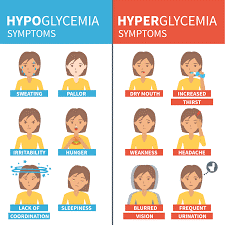A nurse is providing teaching to a client who has a new diagnosis of type 1 diabetes mellitus. The nurse should instruct the client to monitor for which of the following findings as a manifestation of hypoglycemia?
Irritability
Increased urination
Vomiting
Facial flushing
The Correct Answer is A
A. Irritability: Correct. Irritability is one of the signs of hypoglycemia, which occurs when blood glucose levels fall below 70 mg/dL (3.9 mmol/L). Other signs include shakiness, sweating, hunger, headache, confusion, and blurred vision.
B. Increased urination: Incorrect. Increased urination is one of the signs of hyperglycemia, which occurs when blood glucose levels rise above 180 mg/dL (10 mmol/L). Other signs include thirst, dry mouth, fatigue, nausea, and fruity breath odor.
C. Vomiting: Incorrect. Vomiting is not a specific sign of hypoglycemia or hyperglycemia, but it can occur as a complication of either condition if left untreated or poorly managed.
D.Facial flushing: Incorrect. Facial flushing is not a sign of hypoglycemia or hyperglycemia, but it can occur as a side effect of some medications used to treat diabetes, such as niacin or rosiglitazone.

Nursing Test Bank
Naxlex Comprehensive Predictor Exams
Related Questions
Correct Answer is A
Explanation
A. Advocacy is a leadership role that helps others to self-actualize. This statement is true and reflects one of the core principles of advocacy, which is to empower others to achieve their full potential and exercise their rights and responsibilities. This choice is correct.
B. Subordinates are advocates for the nurse manager. This statement is false and contradicts one of the core principles of advocacy, which is to act in the best interest of those who are vulnerable or oppressed, not those who are in positions of power or authority. This choice is incorrect.
C. Advocacy encourages clients to rely on health care staff for decision-making. This statement is false and contradicts one of the core principles of advocacy, which is to respect and support clients' autonomy and self-determination, not to impose or influence their choices or actions. This choice is incorrect.
D. Nurse managers should distrust people who expose inappropriate professional practices. This statement is false and contradicts one of the core principles of advocacy, which is to promote and uphold ethical standards and quality of care, not to conceal or ignore malpractice or misconduct. This choice is incorrect.
Correct Answer is B
Explanation
A. Weight loss is not a common or serious adverse effect of valproic acid. Valproic acid can cause weight gain, not weight loss.
B. Jaundice is a sign of liver damage, which is a serious and potentially fatal adverse effect of valproic acid. Valproic acid can impair fatty acid metabolism and mitochondrial function, leading to hepatotoxicity and steatosis. The nurse should monitor the client's liver function tests and report any signs of jaundice, such as yellowing of the skin or eyes, dark urine, or clay-colored stools .
C. Bradycardia is not a common or serious adverse effect of valproic acid. Valproic acid can cause cardiac arrhythmias, but they are usually tachycardic, not bradycardic.
D. Polyuria is not a common or serious adverse effect of valproic acid. Valproic acid can cause hypernatremia and hypocalcemia, which can affect urine output, but polyuria is not a specific symptom of these electrolyte imbalances.
Whether you are a student looking to ace your exams or a practicing nurse seeking to enhance your expertise , our nursing education contents will empower you with the confidence and competence to make a difference in the lives of patients and become a respected leader in the healthcare field.
Visit Naxlex, invest in your future and unlock endless possibilities with our unparalleled nursing education contents today
Report Wrong Answer on the Current Question
Do you disagree with the answer? If yes, what is your expected answer? Explain.
Kindly be descriptive with the issue you are facing.
